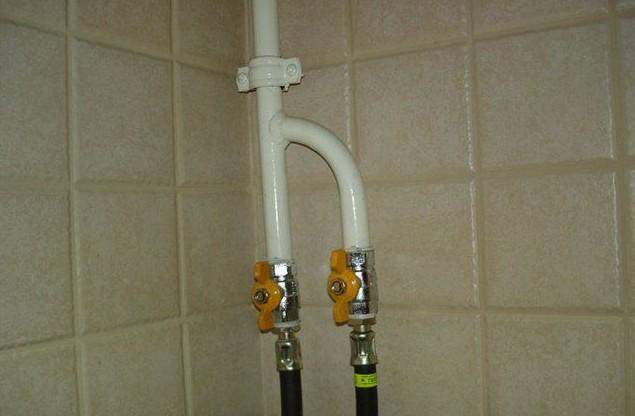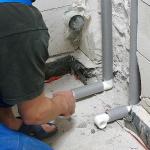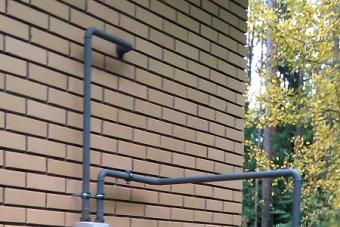The question of whether it is possible to carry a gas pipe in an apartment is considered debatable. But it depends on what is meant by a gas pipe. What does it usually consist of? This:
- the actual riser pipe running along all floors;
- drive, extending to the plate;
- the drive that goes to the geyser (if one is installed);
- connection to AOGV (if there is no central heating in the house);
- flexible hoses going directly to the devices.
Usually big problems arise when you want to move the riser pipe. But work with surges is possible, but it must be carried out by qualified gasmen. On the one hand, the tenant himself can screw a flexible piping to the finished pipe, but you need to know the subtleties. For example, a specialist will definitely lay a linen or synthetic gasket in a threaded connection, just like plumbers do when they connect pipes. The gasket in the threaded connection is a guarantee of no gas leaks.
On the other hand, a specialist will do such work better and faster, and besides, he will give an official guarantee for the eyeliner, and if something happens to it, then you will have somewhere to turn for a free replacement.
Gas pipe capacity table:
When not to install a flexible gas piping
IMPORTANT! If you need to move the stove over a long distance, then you can not use flexible piping. As a rule, the largest length that is possible in a particular case is indicated in the passport of each gas appliance. For some, it cannot exceed 2 m, for others this size can be even larger.
But at the same time, you also need to ensure that the hose does not bend unnecessarily. If the stove cannot be installed otherwise, then the gas pipe must be transferred. In other words, it will have to be increased. Such a pipe should be welded so that there are as few joints as possible through which gas can leak. And this is where the difficulties begin.
Gas is a substance not only combustible, but also explosive. Therefore, the specialist will never be welded directly to the squeegee pipe. Even if he closes the valve and turns off the flow to the apartment, this does not guarantee that local overheating of the blue fuel will not occur in the outlet during welding. Therefore, the pipe is initially measured, a sketch of the drawing is drawn up, according to which the part will be welded, which will then be screwed to the run. This part, no matter how complex configuration it may be, will be made either in the workshop of the housing office, or in any safe place. For example, in the stairwell. Now it remains only to attach it with a coupling.

Branched gas pipe for two gas appliances.
A more complicated case is when the tenant wants to spread the oven and hob to different places in the kitchen. Then it will be necessary to branch out the gas network inside the apartment. And in this case, it is also better to use a welded structure. It is only desirable that each device has its own valve in order to shut off gas access.
Is it possible to transfer the riser gas pipe?
A riser pipe in a multi-storey building is not allowed to be moved. You can bypass all instances, from the operating office and gas facilities to the local architectural department, and not get permission from them. Most likely, one of the authorities, if not all, will not allow this to be done. And they will be right: it is too dangerous to perform such movements from the point of view of the integrity of the building. After all, gas is explosive, and many houses were calculated in such a way that when the gas riser was damaged, the kitchen was ventilated as much as possible, and if a gas explosion occurred, then so that the blast wave itself would extinguish the flame.

Another thing is when the riser pipe needs to be moved in a private house. Here it is easier to obtain permission, and there will be less work and approvals. But in this situation, it is much easier to carry out the wiring of gas after input, that is, already behind the inlet valve.
If you need to carry out the transfer of the heating boiler, then it is better to coordinate such work with the designers of the house, since we are talking not only about gas communications, but also about water circuits and ventilation.
Alas, such work may also be needed. But for the most part - as an emergency. If you have experienced a depressurization of the surge coming from the riser, then there's nothing you can do about it: you have to weld it to the riser. How to do it:
- such work is carried out only by specialists of the local gas industry;
- before welding, all residents of the entrance are notified of the gas shutdown against receipt;
- disconnect the riser;
- weld a new overhang;
- turn on the riser and conduct tests.
Why is it necessary to notify tenants against receipt? Because at the end of the work for them, the gas will turn on unexpectedly. But if they had something cooked on the stove, then even a short-term shutdown of the gas will cause the flame to go out. But at the same time, the valve on the stove will not be closed.
Not every stove is equipped with a gas control function, so it may turn out that gas will simply come out of the burner - poisonous and explosive. If the resident of the house is warned, he will watch the stove and avoid a dangerous situation.

In the same way, you can tie into the riser of another drive, if it is so convenient to separate the gas pipes for different appliances.
Why is it possible to weld on a riser pipe? Because the gas, locked by the valve, will be far from the place of welding, and will not be able to warm up too much. The gas that remains in the riser can be released or burned out by the master before welding.
Any additional tie-in to the riser must be documented by the gas utility. It needs to obtain permission from the management company and the gas industry. If the tie-in is not agreed upon, they can be fined for it and obligated to bring the gas distribution to its original state.
Any work with gas is a very responsible and serious action. This is important to remember.





